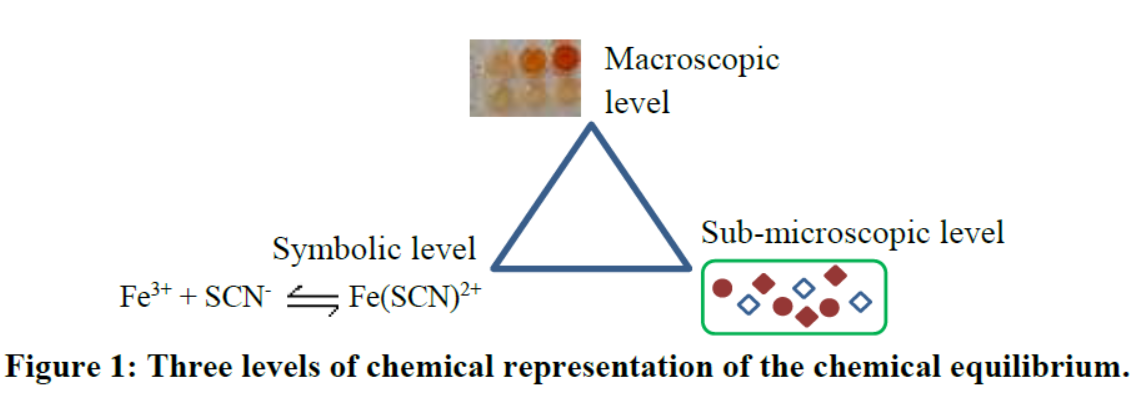Learning Difficulties in High School Chemistry: The Case of Chemical Equilibrium
Main Article Content
Abstract
Chemistry is considered as an importance science for understanding various phenomena in nature and it is also the base for learning other sciences. However, many students across the world are facing difficulties in learning chemistry, especially chemical equilibrium topic. This article reports a non-systematic literature review regarding problems and obstacles of teaching and learning chemistry at the high school level. Students’ difficulties in learning as well as teaching and learning methods for improving students’ learning and conceptual understanding of chemical equilibrium are described.
Article Details

This work is licensed under a Creative Commons Attribution-NonCommercial-NoDerivatives 4.0 International License.
References
Akın, F. N., & Uzuntiryaki-Kondakci, E. (2018). The nature of the interplay among components of pedagogical content knowledge in reaction rate and chemical equilibrium topics of novice and experienced chemistry teachers. Chemistry Education Research and Practice, 19(1), 80–105. https://doi.org/10.1039/C7RP00165G
Akkus¸, H., Kadayifc¸i, H., Atasoy, B., & Geban, O. (2003). Effectiveness of instruction based on the constructivist approach on understanding chemical equilibrium concepts. Research in Science & Technological Education, 21(2), 209–227. https://doi.org/10.1080/0263514032000127248
Aksela, M. (2005). Supporting Meaningful Chemistry Learning and Higher-order Thinking through Computer-Assisted Inquiry : A Design Research Approach. In University of Helsinki.
Banerjee, A. C. (1991). Misconceptions of students and teachers in chemical equilibrium. International Journal of Science Education, 13(4), 487–494. https://doi.org/10.1080/0950069910130411
Bilgin, İ., & Geban, Ö. (2006). The Effect of Cooperative Learning Approach Based on Conceptual Change Condition on Students’ Understanding of Chemical Equilibrium Concepts. Journal of Science Education and Technology, 15(1), 31–46. https://doi.org/10.1007/s10956-006-0354-z
Birch, N. C., & Stickle, D. F. (2003). Example of use of a desktop scanner for data acquisition in a colorimetric assay [2]. In Clinica Chimica Acta (Vol. 333, Issues 1–2). https://doi.org/10.1016/S0009-8981(03)00168-2
Bradley, J. D., & Brand, M. (1985). Stamping out misconceptions. In Journal of Chemical Education (Vol. 62, Issue 4). https://doi.org/10.1021/ed062p318
Doymus, K. (2008). Teaching Chemical Equilibrium with the Jigsaw Technique. Research in Science Education, 38(2), 249–260. https://doi.org/10.1007/s11165-007-9047-8
Eilks, I., & Gulacar, O. (2016). A Colorful Demonstration to Visualize and Inquire into Essential Elements of Chemical Equilibrium. Journal of Chemical Education, 93(11), 1904–1907. https://doi.org/10.1021/acs.jchemed.6b00252
Ghirardi, M., Marchetti, F., Pettinari, C., Regis, A., & Roletto, E. (2014). A Teaching Sequence for Learning the Concept of Chemical Equilibrium in Secondary School Education. Journal of Chemical Education, 91(1), 59–65. https://doi.org/10.1021/ed3002336
Ghirardi, M., Marchetti, F., Pettinari, C., Regis, A., & Roletto, E. (2015). Implementing an Equilibrium Law Teaching Sequence for Secondary School Students To Learn Chemical Equilibrium. Journal of Chemical Education, 92(6), 1008–1015. https://doi.org/10.1021/ed500658s
Hofstein, A., & Lunetta, V. N. (2004). The Laboratory in Science Education: Foundations for the Twenty-First Century. In Science Education (Vol. 88, Issue 1). https://doi.org/10.1002/sce.10106
Johnstone, A. H. (2000). Teaching of Chemistry - Logical or Psychological? Chemistry Education Research and Practice, 1(1), 9–15. https://doi.org/10.1039/a9rp90001b
Kajornklin, P., Jarujamrus, P., Phanphon, P., Ngernpradab, P., Supasorn, S., Chairam, S., & Amatatongchai, M. (2020). Fabricating a Low-Cost, Simple, Screen Printed Paper Towel-Based Experimental Device to Demonstrate the Factors Affecting Chemical Equilibrium and Chemical Equilibrium Constant, K c. Journal of Chemical Education, 97(7), 1984–1991. https://doi.org/10.1021/acs.jchemed.9b00918
Karpudewan, M., Treagust, D. F., Mocerino, M., Won, M., & Chandrasegaran, A. L. (2015). Investigating High School Students’ Understanding of Chemical Equilibrium Concepts. The International Journal of Environmental and Science Education, 10(6), 845–863. https://doi.org/10.12973/ijese.2015.280a
Maia, P. F., & Justi, R. (2009). Learning of Chemical Equilibrium through Modelling‐based Teaching. International Journal of Science Education, 31(5), 603–630. https://doi.org/10.1080/09500690802538045
Masruroh, H., & Diniaty, A. (2020). Development of Chem in Action instructional media based on drill and practice in chemical equilibrium material for students in senior high school. In I. Fatimah, Muhaimin, & M. M. Musawwa (Eds.), 3rd International Seminar on Chemical Education: Trends, Applications, Changes in Chemical Education for the 4.0 Industrial Revolution (p. 020005). AIP. https://doi.org/10.1063/5.0002913
Novak, I. (2018). Geometrical Description of Chemical Equilibrium and Le Châtelier’s Principle: Two-Component Systems. Journal of Chemical Education, 95(1), 84–87. https://doi.org/10.1021/acs.jchemed.7b00665
Ollino, M., Aldoney, J., Domínguez, A. M., & Merino, C. (2018). A new multimedia application for teaching and learning chemical equilibrium. Chemistry Education Research and Practice, 19(1), 364–374. https://doi.org/10.1039/C7RP00113D
Taber, K. S. (2002). Chemical Misconceptions - Prevention, Diagnosis and Cure. Chapter 6: Chemical Axioms. Royal Society of Chemistry, 1.
Tamuang, S., Wuttisela, K., & Supasorn, S. (2017). Low-Cost Small-Scale Chemistry Experiment to Enhance 11-Grade Students’ Conceptual Understanding on Chemical Equilibrium (in Thai). Journal of Research Unit on Science, Technology and Environment for Learning, 8(2), 379–397.
Thomas, G. P., & Mcrobbie, C. J. (2002). Collaborating to enhance student reasoning: Frances’ account of her reflections while teaching chemical equilibrium. International Journal of Science Education, 24(4), 405–423. https://doi.org/10.1080/09500690110074035
Treagust, D. F., Chittleborough, G., & Mamiala, T. L. (2003). The role of submicroscopic and symbolic representations in chemical explanations. International Journal of Science Education, 25(11). https://doi.org/10.1080/0950069032000070306
van Driel, J. H., Verloop, N., & de Vos, W. (1998). Developing science teachers’ pedagogical content knowledge. Journal of Research in Science Teaching, 35(6), 673–695.
Voska, K. W., & Heikkinen, H. W. (2000). Identification and analysis of student conceptions used to solve chemical equilibrium problems. Journal of Research in Science Teaching, 37(2). https://doi.org/10.1002/(SICI)1098-2736(200002)37:2<160::AID-TEA5>3.0.CO;2-M


